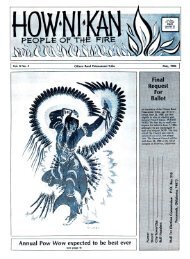December 2011 - Citizen Potawatomi Nation
December 2011 - Citizen Potawatomi Nation
December 2011 - Citizen Potawatomi Nation
You also want an ePaper? Increase the reach of your titles
YUMPU automatically turns print PDFs into web optimized ePapers that Google loves.
22 HowNiKan <strong>December</strong> (Bbon Gises) <strong>2011</strong>, vol. 32 issue 6<br />
<strong>Potawatomi</strong> Cornerstone<br />
by Charles Clark/Tribal Rolls Director<br />
Porte des Mortes: Death’s Door<br />
The Porte des Mortes is the six-mile<br />
wide strait linking Green Bay and Lake<br />
Michigan, between the northern tip of the<br />
Peninsula of Door County, Wisconsin and<br />
an archipelago known as the <strong>Potawatomi</strong><br />
Islands. As the largest, Washington Island<br />
was known as Wassekiganeso, an Ojibwa<br />
name that translates to “His Breast is Shining,”<br />
The name referred to the reflection of<br />
the sun off the limestone cliffs on Plum Island,<br />
Detroit Island, Hog Island, Pilot Island,<br />
and Rock Island.<br />
The <strong>Potawatomi</strong> name for Death’s Door<br />
is translated as Mboshawadem. It is unknown<br />
what the other tribes called the<br />
strait. However, resources indicate they had<br />
a similar meaning for the area. French explorers<br />
picked up on the name and called it<br />
the same thing because of the treacherous<br />
currents and unpredictable wave action.<br />
People navigating through the area often<br />
found the passage unnerving; frequent and<br />
oppressive fog made the passage hazardous,<br />
extremely lonely, and forbidding.<br />
The passage claimed many lives, First <strong>Nation</strong>s<br />
and Europeans alike, as the name suggests.<br />
One of the earliest European explorers to<br />
navigate through these dangerous waters<br />
was Jean Nicolet in 1635, when he visited<br />
the area with fellow traders and missionaries.<br />
Nicolet first arrived in Quebec in 1618,<br />
as a clerk and to train as an interpreter for<br />
the Compagnie des Marchands, a trading<br />
monopoly owned by members of the<br />
French aristocracy. Oddly enough, he died<br />
in 1642, drowning in the St. Lawrence<br />
River in Sillery, near Quebec City, when his<br />
boat overturned in a storm.<br />
Among the earliest known inhabitants of<br />
the Islands were the <strong>Potawatomi</strong>s. They<br />
lived on the islands because they provided<br />
ideal protection against their enemies. One<br />
theory for the origin of the name comes<br />
from a battle between the <strong>Potawatomi</strong>s and<br />
the Winnebagos in the 1650s.<br />
When the Winnebagos migrated to the<br />
region from the southwest, the <strong>Potawatomi</strong>s<br />
initially offered to share the land with them.<br />
However, the Winnebagos, who were more<br />
numerous, pushed the <strong>Potawatomi</strong>s off the<br />
peninsula and onto the Islands.<br />
The Winnebagos were set to cross the<br />
strait and take the islands as well. But, before<br />
they could, the <strong>Potawatomi</strong>s devised<br />
their own plan by sending three scouts to<br />
locate the Winnebagos’ encampment and<br />
light a signal fire at a safe landing zone, so<br />
the <strong>Potawatomi</strong>s could attack from the Winnebagos’<br />
rear.<br />
Unfortunately, the scouts were caught<br />
and tortured. Two of them died with their<br />
secrets, but the third revealed the plan. The<br />
Winnebagos devised a two-pronged attack;<br />
1) they would place a signal fire at a high<br />
bluff giving no place for the <strong>Potawatomi</strong>s<br />
to land and 2) they would send out war canoes<br />
in a roundabout fashion, circling the<br />
<strong>Potawatomi</strong> war party and attacking it from<br />
behind. That would leave no escape exit for<br />
the <strong>Potawatomi</strong>s. From there, the Winnebagos<br />
would be free to move in on the islands<br />
and attack the <strong>Potawatomi</strong> villages that<br />
would no doubt have been left defenseless.<br />
When the <strong>Potawatomi</strong> war party left the<br />
islands, the weather was relatively calm.<br />
But, as they neared the peninsula, the<br />
weather had taken a turn for the worse with<br />
a strong north wind and rough waters. Unable<br />
to turn back, they continued, thinking<br />
that the vanguard had set the signal fire in<br />
a safe landing place.<br />
When the <strong>Potawatomi</strong>s arrived, the Winnebagos<br />
attacked from the safety of the<br />
high ledges, raining down arrows and<br />
spears. Unable to defend themselves, the<br />
<strong>Potawatomi</strong>s tired to retreat but, because of<br />
the turbulent waters, many of the canoes<br />
began crashing into the rocks and capsizing,<br />
setting the <strong>Potawatomi</strong>s in them adrift.<br />
Many drowned.<br />
Some <strong>Potawatomi</strong>s made it to a small<br />
ledge above the waves, but a large number<br />
of Winnebagos jumped onto the ledge and<br />
continued to fight with tomahawks until a<br />
large wave took them all.<br />
The Winnebagos, who had set out in canoes<br />
earlier, never made it to the battle or<br />
attacked the islands. They were never seen<br />
again, and are presumed to have drowned.<br />
Later that day, remnants of the Winnebago<br />
war party’s canoes washed up on<br />
the shore. The Winnebagos took this as an<br />
omen, and never crossed the strait over to<br />
the islands. For them, it was the doorway to<br />
death. And it is there that the legend of the<br />
Door of Death supposedly began.<br />
History does not tell us when the early<br />
French explorers translated the Ojibwa<br />
word for “Door of Death” into Porte des<br />
Morte. But in the fall of 1872 alone, more<br />
than 100 large vessels were stranded or<br />
damaged passing through the “Door.” In<br />
1880, about 30 boats were driven ashore at<br />
Plum Island.<br />
Today, with modern boats, weather forecasting,<br />
accurate charts, and the United<br />
States Coast Guard stationed on Washington<br />
Island, Death’s Door does not prove to<br />
be such a threat to anyone anymore.<br />
Attention<br />
CPN Veterans<br />
All <strong>Citizen</strong> <strong>Potawatomi</strong> <strong>Nation</strong> veterans<br />
are encouraged to contact Stacy<br />
Coon at the CPN Cultural Heritage<br />
Center. Stacy’s contact information is<br />
Stacy.Coon@<strong>Potawatomi</strong>.org, 405-275-<br />
3121, or 800-880-9880.<br />
We would like to ensure that Stacy<br />
and, therefore, Veterans Organization<br />
members know when CPN veterans<br />
have been hospitalized or have experienced<br />
a death in the family. This allows<br />
us to respond more quickly and appropriately<br />
to that veteran’s needs.<br />
Additionally, please ensure that<br />
Stacy and the Veterans Organization<br />
have current contact information for<br />
you.<br />
Finally, you can remain current on<br />
all activities and news of the CPN Veterans<br />
Organization’s activities at our<br />
website: www.CPNVeterans.org.<br />
View<br />
CPN Legislative<br />
meetings<br />
on<br />
www.<strong>Potawatomi</strong>.org

















